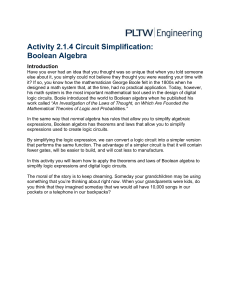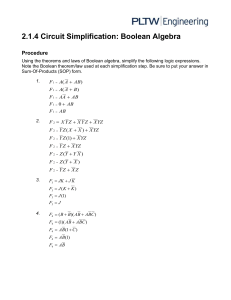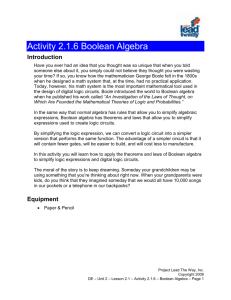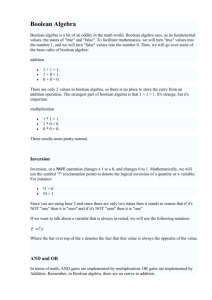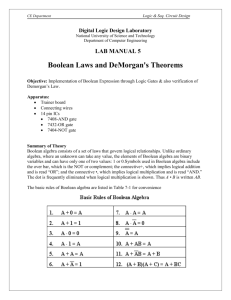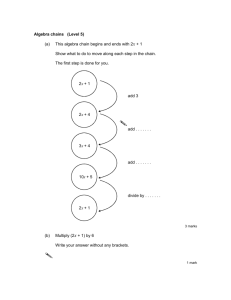Boolean Algebra Activity: Simplify Logic Expressions & Circuits
advertisement
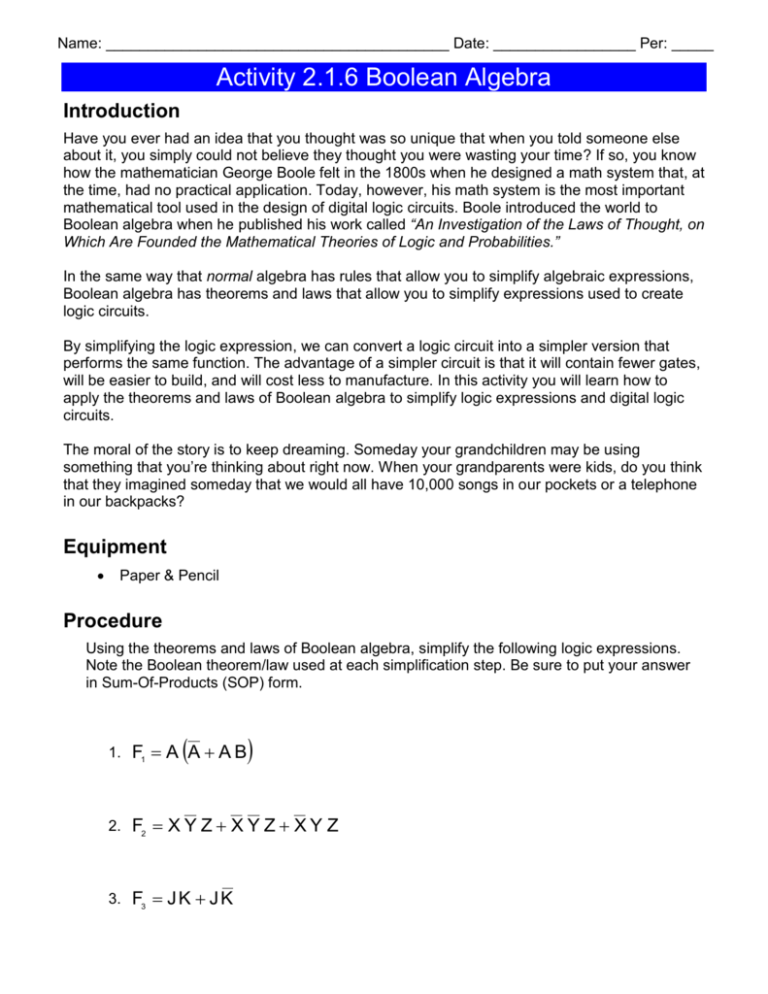
Name: _________________________________________ Date: _________________ Per: _____ Activity 2.1.6 Boolean Algebra Introduction Have you ever had an idea that you thought was so unique that when you told someone else about it, you simply could not believe they thought you were wasting your time? If so, you know how the mathematician George Boole felt in the 1800s when he designed a math system that, at the time, had no practical application. Today, however, his math system is the most important mathematical tool used in the design of digital logic circuits. Boole introduced the world to Boolean algebra when he published his work called “An Investigation of the Laws of Thought, on Which Are Founded the Mathematical Theories of Logic and Probabilities.” In the same way that normal algebra has rules that allow you to simplify algebraic expressions, Boolean algebra has theorems and laws that allow you to simplify expressions used to create logic circuits. By simplifying the logic expression, we can convert a logic circuit into a simpler version that performs the same function. The advantage of a simpler circuit is that it will contain fewer gates, will be easier to build, and will cost less to manufacture. In this activity you will learn how to apply the theorems and laws of Boolean algebra to simplify logic expressions and digital logic circuits. The moral of the story is to keep dreaming. Someday your grandchildren may be using something that you’re thinking about right now. When your grandparents were kids, do you think that they imagined someday that we would all have 10,000 songs in our pockets or a telephone in our backpacks? Equipment Paper & Pencil Procedure Using the theorems and laws of Boolean algebra, simplify the following logic expressions. Note the Boolean theorem/law used at each simplification step. Be sure to put your answer in Sum-Of-Products (SOP) form. 1. F1 A A A B 2. F2 X Y Z X Y Z X Y Z 3. F3 J K J K 4. F4 B B A B A B C 5. F5 X Y X Y 6. F6 J K J K L J K 7. F7 R S R S T S S U 8. F8 N N M N N M N M Almost as important as being able to use the laws of Boolean algebra (i.e., associative, commutative, or distributive) to simplify logic expressions, it is also critical that you are able to identify them. Identify the law of Boolean algebra upon which the following equalities are based. 1. AB ACBCA CBC AB 2. D EF G D E F G 3. R S T U R S T U 4. J K L M J L J M K L K M 5. R ST S V RST RS V Now that you’re practiced simplifying logic expressions, apply your knowledge to simplifying an actual circuit. 1. Shown below is a VERY poorly designed AOI circuit that is part of a coffee vending machine. Write the UN-SIMPLIFIED logic expression for the output Brew. 2. Using the theorems and laws of Boolean algebra, simplify the logic expression Brew. Be sure to put your answer in Sum-Of-Products (SOP) form. 3. In the space provided, draw an AOI circuit that implements the simplified logic expression Brew. For your implement, assume that only 2-input AND gates (74LS08), 2-input OR gates (74LS32), and inverters (74LS04) are available. Draw this circuit in the space provided. Brew Circuit Conclusion 1. Describe the process that you would use to simplify a logic expression using Boolean algebra. How do you know when you are finished simplifying and have arrived at the simplest equation? 2. Other than using Boolean algebra, how could you prove that two circuits are equivalent? 3. If you worked for a company that manufactured the coffee vending machine that used the poorly designed circuit, how much money would your new design save the company annually if each GATE cost 15¢ and the company made 500,000 vending machines per year. As an experienced engineer, you earn $75 per hour. The total redesign took you two hours (including a coffee break). What would the company’s Rate-Of-Investment (ROI) be on your time? x 100% ROI Savings Cost Was it a good investment?
